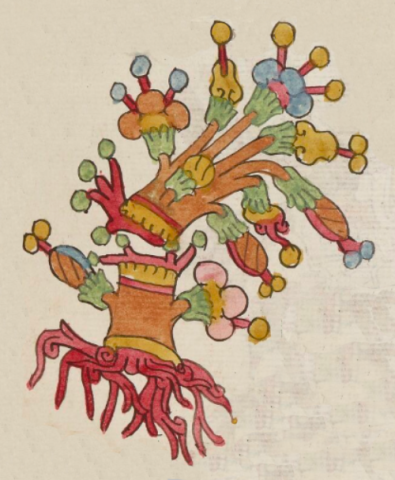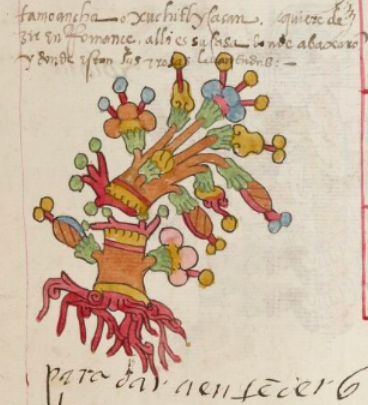Tamoanchan (TR13r)
This colorful iconographic example shows the tree associated with Tamoanchan. It is multicolored, with flowers and curling, red roots showing. The tree is severed in the middle, with red and yellow scalloped edges and red blood spurting from the cut. The red blood has green drops at the tips of the spurts. The trunk is otherwise an orange color.
Stephanie Wood
Tamoanchan is a place of origin recognized by central Mexican peoples. Itzpapalotl is a female divine force charged with guarding the tree. In the Codex Borgia, the tree is a wounded serpent. [See David Carrasco and Scott Sessions, Cave, City, and Eagle's Nest, 2007, p. 368.] The severed trunk here has the yellow scalloping and red band next to that, which is reminiscent of severed human body parts. That a tree could bleed is also evidence of a certain way of thinking of plants. For more on these red and yellow associations with transitions between exteriors and interiors, please see the article on the left navigation bar.
Stephanie Wood
pintā este arbol ensangrētado y
quebrado por medio como quiē dize fiesta
pintan este árbol ensangrentado y quebrado por medio como quien dice fiesta
Stephanie Wood
ca. 1550–1563
Jeff Haskett-Wood
origins, origenes, nombres de lugares

Tamoanchan, a legendary place of origin, a paradise, as explained in our Online Nahuatl Dictionary, https://nahuatl.wired-humanities.org/content/tamoanchan
Telleriano-Remensis Codex, folio 13 recto, MS Mexicain 385, Gallica digital collection, https://gallica.bnf.fr/ark:/12148/btv1b8458267s/f51.item.zoom
The non-commercial reuse of images from the Bibliothèque nationale de France is free as long as the user is in compliance with the legislation in force and provides the citation: “Source gallica.bnf.fr / Bibliothèque nationale de France” or “Source gallica.bnf.fr / BnF.”

